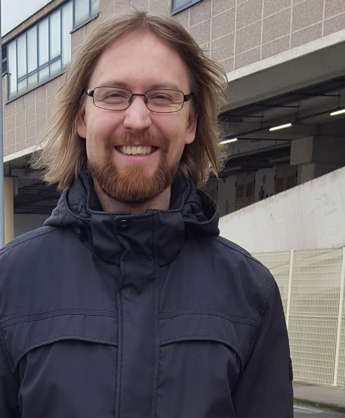Mike Geven defended his PhD thesis on Wednesday 9th of May 2018 and has been awarded the doctor's title cum laude.
THE TITLE OF HIS THESIS IS "ADDITIVE MANUFACTURING OF BONE-FORMING COMPOSITE IMPLANTS USING PHOTO-CURABLE POLY(TRIMETHYLENE CARBONATE)-BASED RESINS"
Mike is a student in the research group Biomaterials Science and Technology. His supervisor is prof.dr. D.W. Grijpma from the faculty Science and Technology (TNW).
 Bone is a tissue that is generally able to perfectly restore and remodel itself after fracture or the formation of a defect due to traumatic injury or tumor removal. In some cases however, critical size bone defects are formed. These are of such size that the bone tissue surrounding the defect is unable to restore the damaged site. Implantable structures are then needed, to act as a temporary support and to induce de novo bone formation in the defect. Most synthetic implants are currently outperformed by natural bone grafts, often harvested from a patient or from an allogenic or xenogenic source. The use of these grafts comes with several disadvantages however, such as risk for disease transmittance, graft rejection and limited options for shaping. Thus, novel synthetic implants are required which do not possess the disadvantages of natural grafts and perform similarly well.
Bone is a tissue that is generally able to perfectly restore and remodel itself after fracture or the formation of a defect due to traumatic injury or tumor removal. In some cases however, critical size bone defects are formed. These are of such size that the bone tissue surrounding the defect is unable to restore the damaged site. Implantable structures are then needed, to act as a temporary support and to induce de novo bone formation in the defect. Most synthetic implants are currently outperformed by natural bone grafts, often harvested from a patient or from an allogenic or xenogenic source. The use of these grafts comes with several disadvantages however, such as risk for disease transmittance, graft rejection and limited options for shaping. Thus, novel synthetic implants are required which do not possess the disadvantages of natural grafts and perform similarly well.
This thesis describes the preparation and characterization of a novel composite material of photo-crosslinked, methacrylate end-group functionalized poly(trimethylene carbonate) (PTMC-MA) and nano-hydroxyapatite (nHA) particles. Specifically, the thesis describes the preparation of these composites by the use of additive manufacturing techniques and the characterization of the fabricated composite structures in terms of in vitro and in vivo performance as bone restoring implants.
The nHA can readily be incorporated in a photo-crosslinked PTMC-MA matrix by dispersing it in solutions of PTMC-MA in non-reactive solvent before crosslinking the matrix. This results in homogeneous composites in which the nHA plays a crucial role in controlling the mechanical properties, hydrophilicity and degradability. By elevating the nHA particle content from 0 to 40 wt.%, stiffness, strength and toughness of the composites can be greatly improved. As the nHA enhances the hydrophilicity of the composite, it also affects the degradation of the photo-crosslinked PTMC-MA matrix in aqueous medium. The degradation of PTMC proceeds via enzymatic pathways in the presence of cholesterol esterase or lipase enzymes. By incorporation of nHA in the photo-crosslinked PTMC-MA matrix, aqueous media are able to penetrate into the bulk of the composite. As the nHA content is increased, the penetration of medium is enhanced and a large surface area of photo-crosslinked matrix becomes available for degradation by enzymes. Cholesterol esterase and lipase therefore degrade the composites more strongly as the nHA content is increased. Furthermore, the composites become more susceptible to acidic media as nHA is soluble in an acidic environment. In vivo both enzymes and acidic conditions will be present in a bony defect site. The nHA content may therefore be used to control the degradation of the structure in vivo. This is desirable as an implanted material is ideally resorbed while being replaced by newly formed bone.
Photo-crosslinked PTMC-MA and nHA composites may be prepared by various additive manufacturing techniques, in order to fabricate a material with a designed external as well as internal structure. The external structure can for example be designed according to a computed tomography scan of a patient’s bone defect, whereas an interconnected porosity may be designed to allow for ingrowth of bone and vasculature into the composite before it degrades. In this thesis, two additive manufacturing techniques were applied to prepare composites of photo-crosslinked PTMC-MA and nHA. Stereolithography was used to prepare well-fitting implants with complex shapes, for reconstruction of orbital floor bone. A low-temperature extrusion-based additive manufacturing technique was used to prepare composite structures with designed macro-scale porosity (several hundreds of micrometers) and micro-scale porosity (in the range of ten micrometer). Here, the macro-scale porosity may allow for bone ingrowth, whereas the micro-scale porosity can allow for nutrient diffusion throughout the structure once implanted.
Although the composites produced by both techniques are cytocompatible and allow for osteogenic differentiation of human bone marrow mesenchymal stem cells on their surface, the majority of biological characterization of the composites in this thesis is focused on composites prepared by stereolithography. Composite structures prepared by this technique show a strong surface enrichment with nHA particles as the particle content is increased. This results in an enhanced protein adhesion on the composite surface, and an enhanced release of calcium from the composite. Ultimately, it results in enhanced bone defect restoration and a better osseointegration of the structures in newly formed bone, as shown in small animal experiments.
Overall, the work in this thesis shows that composites of photo-crosslinked PTMC-MA and nHA may indeed be useful in bone tissue engineering applications. Increasing nHA contents can be used to enhance the mechanical properties, hydrophilicity and the degradability of the composite. More importantly, it improves the bone regenerating capability. Lastly, the ability to prepare these composites by different additive manufacturing techniques is highly attractive as it allows for the fabrication of implantable structures with a designed external and internal architecture.





